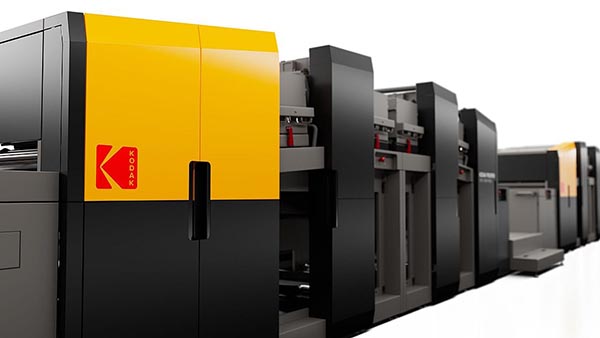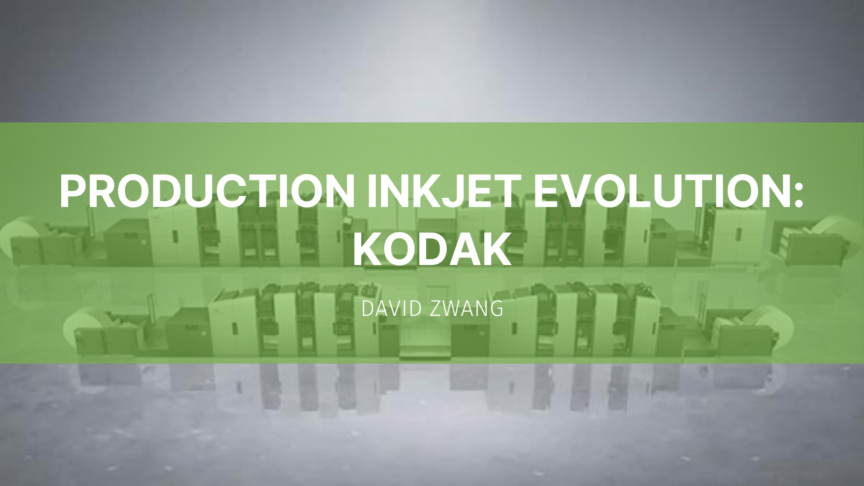Part of a series discussing how production inkjet has evolved, how it is used, and where we can expect it to go and grow. Each of the production inkjet manufacturers and suppliers will be covered, beginning with Kodak.
Yesterday
In looking at the evolution of production inkjet leading up to drupa 2024, it seems fitting that we start with Kodak, since Kodak’s production inkjet roots date back to the 1970s. Here is a link to the original article and a brief history for those of you who are unfamiliar. In 1983, Kodak acquired Mead Digital Systems, which introduced its first commercially available inkjet product in 1976. Kodak initially acquired the company as a wholly owned subsidiary then fully merged it with their Diconix division which had produced the first portable inkjet printer in 1984. In 1993, Diconix was acquired by Scitex, who further developed the technology and launched two Versamark production inkjet products in 2001. These were effectively the first production inkjet printers. Kodak reacquired Scitex Digital Printing in 2004 and never looked back.
In 2009, the Kodak Enterprise Inkjet Systems Division (EISD) introduced their Stream Continuous Ink Jet (CIJ) technology along with two lines of PROSPER production inkjet products; one for imprinting and the other being complete high performance presses. Continuous Ink Jet (CIJ), takes a different approach to imaging. There is no start and stop of drop generation as in (Drop on Demand) DoD. Instead, the printhead continuously generates a flow of ink through the nozzle at a high pressure to reduce nozzle clogging.
Kodak developed patented inks especially for the Stream Inkjet Technology using a micro media milling technology. The Nano particulate (10–60nm median particle size), pigment-based inks also include polymeric dispersants to enhance image permanence, water resistance, and reliability. The water based ink pigmented process inks have an exceptionally wide gamut, claimed to be 35% larger than a comparable 175-line offset printing on coated stock. Additionally, they offer optimizer agents, which offers pre-coating to allow the user a much wider selection of running media.
In 2016 Kodak introduced their scalable Ultrastream technology. This fourth generation, newly announced High Definition CIJ technology has been a high value project in the EISD labs for a while. Unlike the Stream technology that uses an air stream to deflect the unused drops, ULTRASTREAM Technology uses a charge electrode to create charged and uncharged droplets. The charged droplets are deflected and recirculated, the uncharged drops are deposited on the substrate. According to Kodak, it delivers more than 400,000 drops per second per nozzle, with a print frequency 3X faster than the fastest DoD technologies.
In addition to using it for a new press; The PROSPER Ultra 520 Kodak has been working with companies in the decorative and functional printing space on OEM relationships for their Ultrastream Technology. For example, in partnership with flexographic press manufacturer UTECO, they have developed two different flexible packaging presses the Sapphire and the Sapphire EVO. The printing modules for OEMs, support print bar widths from 8 inches to 97 inches, which opens it up to lot of potential applications. Some of these new areas include; industrial substrates, printed electronics, biomedical and 3D applications, just to mention a few.
Today
While Kodak still sells its Versamark imprinting systems, and they are still actively used, most of their focus is on their Stream and Ultrastream CIJ technologies.
PROSPER S for Imprinting
As mentioned earlier, there are two different PROSPER product lines. The PROSPER “S” line is a self-contained imprinting system that can be installed on an existing web offset printing press. This gives you the benefits of variable data without the need to purchase a completely new press. It is offered in multiple speed configurations S5, S10, S20, and S30, each designed for different applications and levels of productivity.
PROSPER Presses
There are currently three versions of PROSPER Presses. Each are tailored to support different application requirements.

The PROSPER 7000 Turbo Press is a full-color perfecting press, which can run from 200 mpm (650 fpm) up to 410 mpm (1,345 fpm) depending on the quality requirement. It has an imaging width up to 62.1cm (24.45-in.), with a variable cutoff up to 54-in. It can print on a wide variety of media from 28# newsprint to 100# cover including uncoated free sheet groundwood and matte, glossy and silk coated papers 42–270 gsm (3–12 pt). It uses aqueous based pigment cyan, magenta, yellow and black inks which are certified for indirect food contact.

The PROSPER 6000 is a modular press that is offered in three versions: 6000S (high coverage commercial), 6000P (perfecting), and 6000S (simplex imprinting) with configurable web paths in either a “U” or “L” configuration. It can run from 650 fpm (200 mpm) to 1,000 fpm (300 mpm) depending on quality requirements supporting the same imaging widths and cutoff. This modularity has been used in interesting applications, like integrating it with flexo stations for short-run or variable folding carton production. For example, it allowed Zumbiel Packaging to leverage the benefits of lower cost flexo inks for most of the coverage, while adding digital inks where it is needed on their folding carton press. This model has helped Zumbiel control its costs and provide more economical and lower minimum order quantities to its clients.

The PROSPER ULTRA 520 targeted at commercial print. Using Ultrastream (their latest printhead technology), the press delivers print quality comparable to 200 lpi offset on uncoated, coated, glossy, and silk papers. It prints full-color 4/4 perfecting output with a scalable web width of up to 21 inches (533mm) at speeds of 500 feet per minute (150 mpm). The press was designed to produce high-quality print at a compellingly low cost per page. Kodak has recently released their Kodachrome inks for this press which use very narrow particle size distributions with pigment particles that are typically less than 50 nanometers. This process delivers higher quality prints with brighter, purer colors, and a larger color gamut with less ink laydown.
All of the presses are driven by Kodak DFEs and compatible with their Prinergy workflow solutions and a wide variety of third-party finishing equipment.
A Kodak Customer’s Inkjet Journey
Japs-Olsen has been a printer for over 100 years focusing on direct mail, located in St. Louis Park, Minn. According to Pat Murray, President of Japs-Olsen, they were an early adopter of inkjet technology. In fact, “We have been using Versamark imprinting systems on our finishing and mailing equipment for decades, since its introduction.” To put their volume in perspective, last year they mailed over 1 billion pieces. When Kodak initially introduced the PROSPER S imprinting systems, Murray thought they could use them directly on their 57-in. Sunday Web Presses, and add variable color and streamline their total direct mail production. In the early days of the Prosper S, around 2009, while they could print process color, Murray’s clients didn’t feel the quality of the variable process color was acceptable. So instead they started to use the imprinting system for variable black and spot colors, and that worked great and still does today!
As a “longtime and happy customer of Kodak,” they looked at the PROSPER 5000 around 2010 when it was introduced, but they didn’t think the quality was ready for Japs-Olsen’s current and future types of work. However, when Kodak introduced the PROSPER 6000C in 2014, Murray knew that this was going to be what they needed for variable full-color printing and they jumped in as a beta site. Since that first 6000C they added a second 6000C as well and increased their volume. The interesting thing is that these presses didn’t replace the work being done on the web offset presses; rather, it ended up being used for different work. These inkjet purchases allowed Japs-Olsen to take on a new mix of product offerings.
Japs-Olsen is a company that embraced inkjet in its infancy along with all of the challenges and opportunities that came with it. Yes, there were fits and starts, but their innovative spirit and creativity in how to use the technology has undoubtedly contributed to their success. In their next chapter, Murray thinks that production inkjet webfed and cutsheet are probably in their future and they are looking forward to the next stage of their journey, and I am interested to hear about it!
Kodak’s Journey
As the pioneer in production inkjet printing, there were lots of great landmark opportunities and lots of challenges. As I interviewed Randy Vandagriff, Director of Digital Print for Kodak, it is obvious that their history in production inkjet is really the industry’s history. There is a great interview video, with the link at the top of the article, that really describes some of the challenges that most, if not all, production inkjet manufacturers have had to address during their journeys as well.
Here is one short story according to Vandagriff: “We were doing 300 dpi back in 1984–1985. And one of the programs I worked on was to take the black-and-white word processing machine that we had developed and create a process color machine with it. So we did CMYK on that and began our studies around color printing and inkjet color. I remember us looking at the screening and the dithering. Nobody had ever done this before, and we didn’t really know what it was going to look like when you do this with inkjet. We had a great guy back then who used to come down to my lab because I had the printer that me and two technicians built. Every day he’d bring new files and write gray scales and all kinds of things to image. That is how we started working with what became Versamark. It was a great platform that we took back into the direct mail and big commercial houses, who immediately saw the benefits. And that’s when we started doing the next generation of addressing.”
Just the Beginning
For both Kodak and Japs-Olsen, each of their production inkjet journeys has been educational, bumpy, profitable and not necessarily what they had initially expected. However, not only aren’t there any regrets, they have both committed to production inkjet and the many benefits it has and will continue to offer.
More to Come…
I would like to address your interests and concerns in future articles as it relates to production inkjet and the manufacturing of Print, Packaging, and Labels, and how, if at all, it drives future workflows including “Industry 4.0.” If you have any interesting examples of hybrid and bespoke manufacturing, I am very anxious to hear about them. Please feel free to contact me at david@zwang.com with any questions, suggestions, or examples of interesting applications.

